A Failure To Communicate – Part Two
Thanks to Mike Gartland and John Morrow, The Kirby Effect is offering Mike’s “A Failure To Communicate” series from The Jack Kirby Collector. – Rand
Part Two was first published in TwoMorrows’ December 1998 Jack Kirby Collector 22.
What can be written about Galactus that hasn’t been expressed already by historians far more informed and eloquent than I? But let’s start off within the context of the theme of The Jack Kirby Collector 22: Is he a villain? By textbook definition he is not; he’s more of an adversary or antagonist, and given the previous opponents superheroes had faced up to his appearance, he represents either the ultimate adversary or antagonistic overkill — take your pick!

Original art, “And Now, Galactus!” page 13,
Pencil story art by Jack Kirby, dialogue by Stan Lee, ink art by Vince Colletta, lettering art by Sam Rosen
first published in Marvel Comics’ The Mighty Thor 160, January 1969.
Scan from the Kirby Museum’s Original Art Digital Archive.
Galactus is a prime example of the thinking man’s opponent; i.e. an adversary that is so powerful it quickly becomes apparent that physical opposition will do no good in subduing him. A plan has to be devised or a way found to defeat him. In earlier stories for Marvel, Jack played with the notion of an alien visitor of enormous power, but they were more or less misguided (Impossible Man or Infant Terrible), or they posed no threat to mankind (the Stranger). Galactus, on the other hand, is not misguided — quite the contrary; because of his very reason for being, he poses the ultimate threat to mankind.
In interviews, Jack would say that “Galactus was God”; I always wondered if Jack really meant God. Granted, Galactus was definitely a “god” but surely not The God. To speculate, perhaps Jack was saying that if super-heroes were ever to face God, Galactus would be about as great an adversary as they could encounter. Superheroes have faced aliens before, and powerful ones too; but it was the way Jack interpreted Galactus to the reader that made him the first space god. How he was introduced made all the difference to the history of comics. His coming is heralded by not one, but two powerful aliens before he even arrives, telling the reader in essence that this was not your typical visiting alien menace; this is the menace; this is IT!
Jack introduced Galactus in Fantastic Four #48’s “The Coming Of Galactus!”; the second half of the book is utilized to prepare readers for his arrival, which culminates with the last page. This gives you an idea of what Jack was thinking about; devoting half an issue just to prepare the reader was saying something about this character. Things really get moving with #49’s “If This Be Doomsday!” and we are very fortunate to have these uninked pencils from that historic story. As opposed to Part One of A Failure To Communicate, there is no failure to communicate between Kirby and Lee on this storyline. Stan followed Jack’s direction without making major changes, and the story flows beautifully because Lee stuck to Kirby’s plotting — and let there be no mistake about who plotted and paced this story. Despite whatever input Stan might or might not’ve had at the conceptual phase, these margin notes show the action and dramatic impact of this pivotal episode in Marvel’s history begin with Kirby. But while Jack was the “father” of Galactus, we shall see — to his credit — Lee may have been his savior.
“If This Be Doomsday!”
Pencil story art by Jack Kirby, dialogue/captions by Stan Lee, lettering art by Sam Rosen
First published in Marvel Comics’ Fantastic Four 49, April 1966.
- page 1
- page 2
- page 3
- page 4
- page 5
- page 6
- page 7
- page 8
- page 9
- page 10
- page 11
- page 19
As far as Silver Age Marvel history is concerned, there is the period before Galactus, and the period after. With the introduction of this character, Jack entered into a period of cosmic creativity; granted he was always creating technological wonderment, but now he was incorporating the Universe in many of his ideas. After Galactus came Sub- Space, the Kree, the Colonizers, Ego the Living Planet; even the Trolls in Thor had Orikal — a powerful alien — in their company. It was space-age mythology fathered by Kirby, and Kirby’s new “Zeus” was Galactus.
Jack has said that after creating Galactus he had to “step back from him.” According to historian Mark Evanier, Kirby never meant for Galactus to be a recurring menace à la Dr. Doom. He might use him again, but only sparingly, so as to maintain the awesome nature of the character. Needless to say, Galactus became an immediate hit with the readers of the time. Ever in touch with the fan base, Lee undoubtedly heard their pleas for his return. According to Evanier, after prompting from Stan, Jack brought Galactus back in not only Fantastic Four, but Thor as well. So thanks to Lee (and the fans), we have more great Kirby Galactus stories and art than probably would have existed otherwise.
Before returning Galactus to the FF, Jack added a small cameo to his Thor/Ego story in The Mighty Thor #134’s “The People Breeders!”; just as Thor leaves the Black Galaxy (where Ego dwells) we see the great Galactus appear. He is scanning the Black Galaxy, whetting our appetite for a Galactus/Ego confrontation. Jack then “steps back” from Galactus, not using him again until Lee requests a Galactus story in FF. Jack eventually returns to the Galactus/Ego “seed” he planted in Thor #160’s “And Now, Galactus!”, more than two years later, finally bringing his classic mythological figures and space god together for several stories. The Ego story leads to an “Origin of Galactus” plotline that eventually culminates in Thor #169’s “The Awesome Answer!”.
Jack touches on the origin story in Thor #162’s “Galactus Is Born!” but then leaves it, not returning to it until #168’s “Galactus Found!”. It is unclear why this is so; Evanier feels that Jack definitely wanted to pen the origin of this character. But there was, by this time, a failure to communicate with Lee, who may have had his own ideas of the character’s beginnings. As seen in TwoMorrows’ February 1977 The Jack Kirby Collector 14, when the Galactus sequence was completed, there were many unused pages left over, but none of them pertained to the origin part of the storyline itself; so Jack was at least able to put an origin in before “losing” the character to someone else — or leaving Marvel, which he did less than a year later. (It’s still unclear how much of the published origin was Jack’s idea, and how much was Stan’s.)
At the end of the unpublished pages from the origin sequence, Kirby was going to have Galactus battle alongside Thor; perhaps Jack scrapped the idea, or Stan (wisely) rejected it, thinking that it would lead to the character’s denigration (which, as we have seen from subsequent stories after Jack left — and overuse of the character it probably would have). In my opinion, to this day no one has yet been able to capture the awesome nature of Galactus as well as his creator, Jack Kirby.
What made Galactus so riveting a character? From the outset, everyone who knows of him before he appears is rendered in characterizations of fear, dread, and awe: The Skrulls, the Watcher (whom we already knew to be an extremely powerful character), and even after Galactus appears, the Surfer as well. In the uninked splash to “If This Be Doomsday!” we see how awestruck the FF are — much moreso than in the inked version. Most telling was the reaction of the everyday people scattered throughout the storyline. This was indeed the coming of a god — Kirby’s god — and it terrified plenty.
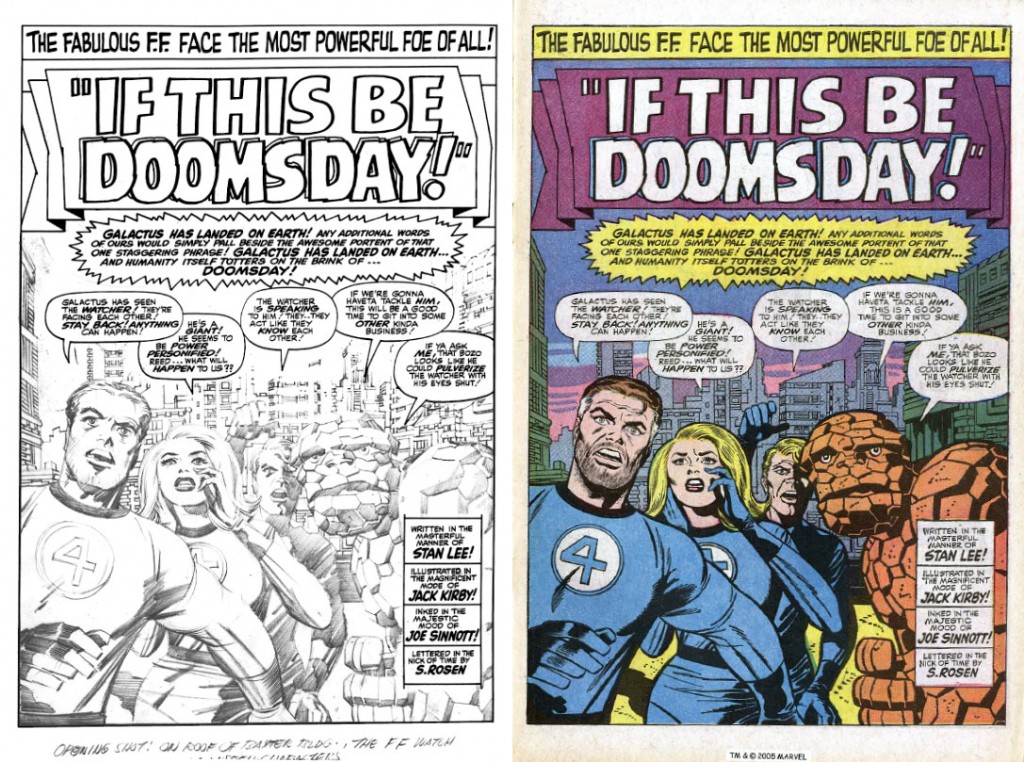
Pencil art with dialog/captions and lettering next to first publication, “If This Be Doomsday!” page 1
Marvel Comics’ Fantastic Four 49, April 1966
What made Galactus so terrifying? Was it his power? The fact that he could destroy the entire planet? Probably in part but what made him terrifying to me was more psychological: The fact that Galactus did not even recognize that man existed, or cared if he existed, or needed to exist; the fact that Galactus made man look at himself and say “I kill what I need (or want) to survive; not bothering to rationalize if what I kill has a right to live.” Heck, we don’t worry about a carrot’s right to life, so when we realize that we are as little to Galactus as a carrot is to us, it’s enough to scare the hell out of you — not so much when you read it as a kid, ironically. Only as “rational” adults do we realize how scary this concept is. And the topper is you can’t condemn him without condemning yourself. So in the end we see man as an extension of God; but in the long run Galactus — God — is an extension of man. Galactus is man, pushed to the ultimate degree; a terrifying concept indeed!


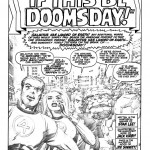
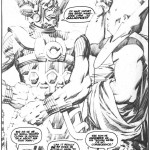
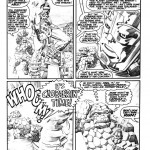
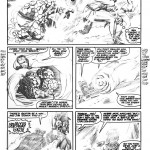
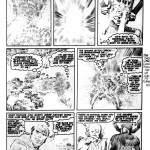
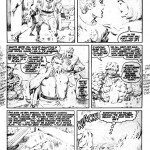
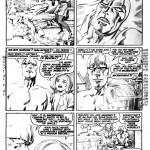

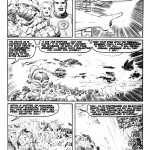
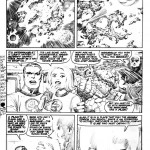


It’s interesting to compare Kirby’s conception of Galactus to Lee’s. As Mike points out Kirby created a character who is not a villain.
Kirby’s Galactus is simply going about his business, and as we’ll see in a later FTC Kirby’s Surfer is a blank slate, as opposed to the disjointed character seen in Lee’s rewrite, where Lee’s Silver Surfer is at once a sensitive man with a past, and the person who marks worlds for slaughter.
Kirby: I went to the Bible. And I came up with Galactus. And there I was in front of this tremendous figure, who I knew very well, because I always felt him, and I certainly couldn’t treat him the same way that I would any ordinary mortal … and of course the Silver Surfer is the fallen angel. Galactus in actuality is a sort of god. He is beyond reproach, beyond anyone’s opinion.
Contrast this with Lee’s comments.
STAN LEE: Right. I wanted to have a villain called Galactus. We had so many villains who were so powerful.
I was looking for somebody who would be more powerful than any. So I figured somebody who is a demigod who rides around in space and destroys planets.with something like Galactus it was me who said, “I want to do a demi-god. I want to call him Galactus.” I told Jack about it and told him how I wanted the story to go generally. And Jack went home, and he drew it.
But in writing the book (Origins of Marvel Comics) I wanted to make it look as if we did it together. So I said we were both thinking about it, and we came up with Galactus.
Q. So, for example, with regard to the Silver Surfer, who decided to essentially take the Silver Surfer and make him a separate character?
STAN LEE: Oh. Me.
I’d like to add that at the time I wrote this piece my father had passed away a few weeks before, leaving me in no condition to properly research the topic; but John needed the piece for the issue so I did what I could. Maybe I’ll add to it someday. I remember I wanted to title the piece “God”, but John thought it blasphemous and nixed it, oh well!
My thanks to Pat for his input and if anyone’s interested my personal opinion on Stan’s commenting on his part in the creation of Galactus is that it is typical Stan Lee and I don’t think I need to go further!
Thanks to those who are entertained by my work, John, Rand, and of course Jack!
Mike Gartland
Mike, I would love to see you expand and collect the Galactus and Surfer articles. With more digging you could even include the later material in THOR which you touch on here. I remember you were not inclined get involved in TJKC’s article on the origin of Galactus Kirby had envisioned for THOR. The story Kirby intended was never completed, and what he did complete was chopped up and reconfigured so Kirby’s story doesn’t exist, and can’t be reconstructed. That doesn’t mean there isn’t a lot in the pages which tell us about what Kirby had in mind.
Hi Pat,
The piece John ran on the Kirby Galactus origin in one of the later JKCs concluded that Jack’s intention was to have the Watcher as the creator of Galactus; I saw no evidence of this. The Watcher could have been responsible for Galactus insofar as letting him go when he had the chance to put a stop to him in the beginning, to me it went against the Watcher’s character to be experimenting on another being. In attempting to save him he could’ve inadvertantly created what would become Galactus, but this is all speculation and I feel we already have too many people stating what they say are Jack’s intentions, when in truth they really can’t be sure, but it’s the way they want it to be! We can only wait for the originals to surface and hope Jack’s notes will tell the true story.
Mike Gartland
Mike, I agree and felt the article would have been improved if it had stuck only with the known facts rather than attempting to reconstruct something which didn’t exist. We don’t even know if Kirby completed the first story before changes were ordered. Since Kirby retained many of the rejected pages it’s clear the story never made it to New York before Kirby was told major changes were needed.
What I’ve always wanted to see looked at would be Jack’s penciled copies and typed script for the Silver Surfer graphic novel compared to the published book as edited and rewritten by Stan Lee. That would be easy to do since Mark Evanier has Kirby’s script, and photocopies exist for almost the whole book.
ME: Jack drew the book and typed out a panel-by-panel breakdown of the plot. I have a copy.
Title changed…
John’s gonna smite thee…
Great to see you here, Mike! A terrific series… it will be great to expand on it with subsequent research.
Thanks Mike, who am I to argue with one with such a learned and intelligent name….
Maybe too much is made of the word “villain”. Lee may have simply meant the antagonist to the hero. He didn’t write Galactus as villainous.
From Lee’s recent deposition which is posted at the Justia along with a full record of other court documents.
http://dockets.justia.com/docket/new-york/nysdce/1:2010cv00141/356975/
STAN LEE: Right. I wanted to have a villain called Galactus. We had so many villains who were so powerful.
I was looking for somebody who would be more powerful than any. So I figured somebody who is a demigod who rides around in space and destroys planets.
I told Jack about it and told him how I wanted the story to go generally. And Jack went home, and he drew it.
Q. So, for example, with regard to the Silver Surfer, who decided to essentially take the Silver Surfer and make him a separate character?
STAN LEE: Oh. Me.